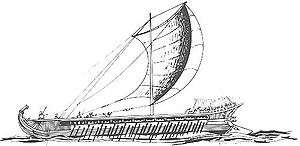Athenian sacred ships

Athenian sacred ships were ancient Athenian ships, often triremes, which had special religious functions such as serving in sacred processions (theoria) or embassies or racing in boat races during religious festivals.[1] The two most famous such ships were the Paralus and the Salaminia, which also served as the messenger ships of the Athenian government in the 5th and 4th centuries BC.[2] Other notable ships included one possibly named the Delias, a triakonter (thirty-oared galley) believed to be the ship in which Theseus had sailed to Crete, and which was involved in several traditional theoria to Delos; the vessel was constantly repaired by replacing individual planks to keep it seaworthy while maintaining its identity as the same ship.[3] (For the philosophical question of the ship's identity, see Ship of Theseus.) After the reforms of Cleisthenes, a ship was named for each of the ten tribes that political leader had created; these ships may also have been sacred ships.[4]
The Paralus and the Salaminia, and possibly some other sacred ships, served in the Athenian combat fleet. Those two vessels, being particularly swift, were used as scout and messenger ships, but also fought in the line of battle.[5] The Paralus and Salaminia, meanwhile, also performed various tasks for the government; the Paralus appears to have carried most diplomatic missions,[6] and the Salaminia carried official state messages;[7] most famously, it was sent to arrest Alcibiades while that politician was commanding the Sicilian Expedition.[8] These two triremes also had dedicated treasurers, or tamiai.[9]
References
- ↑ Jordan, Athenian Navy, 154-157.
- ↑ Jordan, Athenian Navy, 153.
- ↑ Jordan, Athenian Navy, 160-161.
- ↑ Jordan, Athenian Navy, 179; see however Lewis, Athenian Navy, 71, for scholarly caution on expanding the number of sacred ships too far.
- ↑ Jordan, Athenian Navy, 158-159, 167.
- ↑ Jordan, Athenian Navy, 173.
- ↑ Jordan, Athenian Navy, 166.
- ↑ Thucydides, The Peloponnesian War 6.53.
- ↑ Treasurers for the Paralus and another sacred vessel, the Ammonias, are attested at Aristotle, Constitution of the Athenians, 61; and most modern scholars, believing that the Ammonias had replaced the Salaminia, assign a treasurer to the Salaminia as well (see Lewis, Athenian Navy, 71), although Jordan (Athenian Navy, 167, 177) disagrees and assigns the treasurer only to the Ammonias.
Sources
- Aristotle.
 Athenian Constitution. Trans. Frederic George Kenyon. Wikisource.
Athenian Constitution. Trans. Frederic George Kenyon. Wikisource. - Thucydides.
 History of the Peloponnesian War. Trans. Richard Crawley. Wikisource.
History of the Peloponnesian War. Trans. Richard Crawley. Wikisource. - Jordan, Borimir, The Athenian Navy in the Classical Period. (Berkeley, University of California Press, 1975). ISBN 0-520-09482-4.
- Lewis, David M. "Book Review: The Athenian Navy in the Classical Period by Borimir Jordan". Classical Philology Vol. 73 No. 1 1978, pp. 70–72.